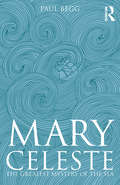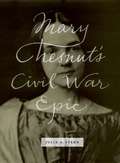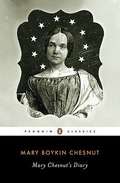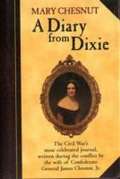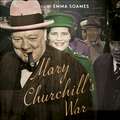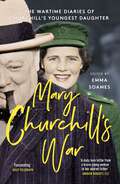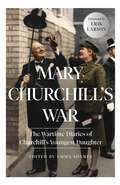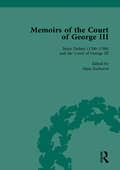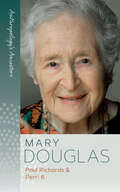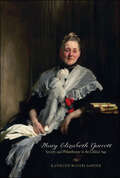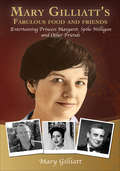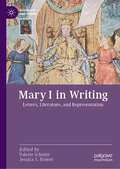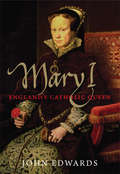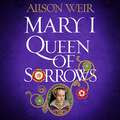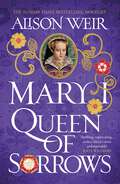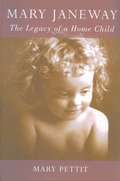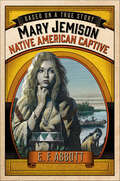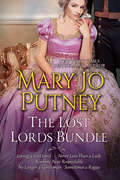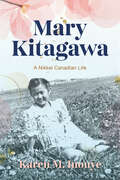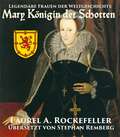- Table View
- List View
Mary Celeste: The Greatest Mystery of the Sea
by Paul BeggMary Celeste is an iconic mystery - a perfectly seaworthy ship found wandering aimlessly at sea, her crew strangely and inexplicably missing.Paul Begg tells the story of the discovery of Mary Celeste and the people who vanished, and investigates over a century's worth of speculation and survivors' tales, searching for the facts behind one of the world's great mysteries.
Mary Chesnut's Civil War Epic
by Julia A. SternA genteel southern intellectual, saloniste, and wife to a prominent colonel in Jefferson Davis’s inner circle, Mary Chesnut today is remembered best for her penetrating Civil War diary. Composed between 1861 and 1865 and revised thoroughly from the late 1870s until Chesnut’s death in 1886, the diary was published first in 1905, again in 1949, and later, to great acclaim, in 1981. This complicated literary history and the questions that attend it-which edition represents the real Chesnut? To what genre does this text belong?-may explain why the document largely has, until now, been overlooked in literary studies. Julia A. Stern’s critical analysis returns Chesnut to her rightful place among American writers. In Mary Chesnut’s Civil War Epic, Stern argues that the revised diary offers the most trenchant literary account of race and slavery until the work of Faulkner and that, along with his Yoknapatawpha novels, it constitutes one of the two great Civil War epics of the American canon. By restoring Chesnut’s 1880s revision to its complex, multidecade cultural context, Stern argues both for Chesnut’s reinsertion into the pantheon of nineteenth-century American letters and for her centrality to the literary history of women’s writing as it evolved from sentimental to tragic to realist forms.
Mary Chesnut's Diary
by Chesnut Mary BoykinAn unrivalled account of the American Civil War from the Confederate perspective. One of the most compelling personal narratives of the Civil War, Mary Chesnut's Diary was written between 1861 and 1865. As the daughter of a wealthy plantation owner and the wife of an aide to the Confederate President, Jefferson Davis, Chesnut was well acquainted with the Confederacy's prominent players and-from the very first shots in Charleston, South Carolina-diligently recorded her impressions of the conflict's most significant moments. One of the most frequently cited memoirs of the war, Mary Chesnut's Diary captures the urgency and nuance of the period in an epic rich with commentary on race, status, and power within a nation divided. .
Mary Chestnut: A Diary From Dixie
by Isabella D. Martin Myrta Lockett AvaryFrom the book: Mary Boykin Chesnut was the wife of James Chesnut, Jr., a South Carolina legislator and U.S. senator who served the Confederacy during the war as as a brigadier-general and as an aide to President Jefferson Davis. In her journal, which eventually became A Diary from Dixie, are vivid pictures of the social life that went on uninterruptedly in the midst of the war; of the economic conditions that resulted from blockaded ports; of the way in which the spirits of the Southern people rose and fell with each victory and defeat; and of the momentous events that took place in Charleston, Montgomery, and Richmond. Mary Chesnut wrote her diary from day to day, as the mood or an occasion prompted her to do so. The fortunes of war changed the location of her home almost as frequently as the seasons changed, but she continued her entries wherever she might be. In all these places Mrs. Chesnut was in close touch with men and women who were in the forefront of the social, military, and political life of the South. Those who live in her pages make up a catalogue of the heroes of the Confederacy- President Jefferson Davis, Vice-President Alexander H. Stephens, General Robert E. Lee, General "Stonewall" Jackson, General Pierre G. T. Beauregard, and many others. As her diary constantly shows, Mary Chesnut was a woman of society in the best sense, noted for her personal warmth as well as for her hospitality. She had a love of companionship, great wit, an acute mind, a knowledge of books, and a searching insight into the motives of men and women. In A Diary from Dixie, as perhaps nowhere else in the literature of the Civil War, can be found the Southern spirit of that time expressed in words that are not only charming as literature but genuinely human in their spontaneousness, their delightful frankness. Truly, as her editors claim, Mary Chesnut's words "ring so true that they start echoes."
Mary Churchill's War: The Wartime Diaries of Churchill's Youngest Daughter
by Emma SoamesA unique portrait of war -- and a charming coming-of-age story -- from the private diaries of Winston Churchill's youngest daughter, Mary.'I am not a great or important personage, but this will be the diary of an ordinary person's life in war time. Though I may never live to read it again, perhaps it may not prove altogether uninteresting as a record of my life - or rather the life of a girl in her youth, upon whom life has shone very brightly, who has had every opportunity of education, interest, travel and pleasure and excitement, and who at the beginning of this war found herself on the threshold of womanhood'In 1939 seventeen-year-old Mary found herself in an extraordinary position at an extraordinary time: it was the outbreak of the Second World War and her father, Winston Churchill, had been appointed First Lord of the Admiralty; within months he would be Prime Minister.The young Mary Churchill was uniquely placed to observe this remarkable historical moment, and her diaries -- most of which have never been published -- provide a front-row view of the great events of war, as well as exchanges and intimate moments with her father. But they also capture what it was like to be a young woman during wartime. An impulsive and spirited writer, full of coming-of-age self-consciousness and joie de vivre, Mary's diaries are untrammelled by hindsight or self-censorship or nostalgia.From aid raid sirens at 10 Downing Street to seeing action with the ATS, from cocktail parties with presidents and royals to accompanying her father on key diplomatic trips, Mary's wartime diaries are full of colour, rich in historical insight, and a charming and intimate portrait of life alongside Winston Churchill.Compiled and edited by Mary's daughter, Emma Soames, in collaboration with The Churchill Archives Centre.(P) 2021 John Murray Audio
Mary Churchill's War: The Wartime Diaries of Churchill's Youngest Daughter
by Emma Soames'A fascinating and intimate insight into the iconic Prime Minister's family life' TELEGRAPH 'I am not a great or important personage, but this will be the diary of an ordinary person's life in war time. Though I may never live to read it again, perhaps it may not prove altogether uninteresting as a record of my life'In 1939 seventeen-year-old Mary found herself in an extraordinary position at an extraordinary time: it was the outbreak of the Second World War and her father, Winston Churchill, had been appointed First Lord of the Admiralty; within months he would be Prime Minister.The young Mary Churchill was uniquely placed to observe this remarkable historical moment, and her diaries -- most of which have never been published -- provide a front-row view of the great events of war, as well as exchanges and intimate moments with her father. But they also capture what it was like to be a young woman during wartime. An impulsive and spirited writer, full of coming-of-age self-consciousness and joie de vivre, Mary's diaries are untrammelled by hindsight or self-censorship or nostalgia.From aid raid sirens at 10 Downing Street to seeing action with the ATS, from cocktail parties with presidents and royals to accompanying her father on key diplomatic trips, Mary's wartime diaries are full of colour, rich in historical insight, and a charming and intimate portrait of life alongside Winston Churchill.Compiled and edited by Mary's daughter, Emma Soames, in collaboration with The Churchill Archives Centre.
Mary Churchill's War: The Wartime Diaries of Churchill's Youngest Daughter
by Emma Soames'It wasn't easy being a Churchill child - and only Mary managed it with serenity and aplomb, as her diary of wartime ATS service shows' ANNE DE COURCY, SUNDAY TELEGRAPH'Mary's affectionately intimate and emotionally volatile diaries [...] are an informal record that perfectly complements Churchill's own six authoritative volumes of memoirs of the second world war ... This is a happy book' SPECTATOR'A fascinating and intimate insight into the iconic Prime Minister's family life' DAILY TELEGRAPH 'I am not a great or important personage, but this will be the diary of an ordinary person's life in war time. Though I may never live to read it again, perhaps it may not prove altogether uninteresting as a record of my life'In 1939 seventeen-year-old Mary found herself in an extraordinary position at an extraordinary time: it was the outbreak of the Second World War and her father, Winston Churchill, had been appointed First Lord of the Admiralty; within months he would be Prime Minister.The young Mary Churchill was uniquely placed to observe this remarkable historical moment, and her diaries -- most of which have never been published -- provide a front-row view of the great events of war, as well as exchanges and intimate moments with her father. But they also capture what it was like to be a young woman during wartime. An impulsive and spirited writer, full of coming-of-age self-consciousness and joie de vivre, Mary's diaries are untrammelled by hindsight or self-censorship or nostalgia.From aid raid sirens at 10 Downing Street to seeing action with the ATS, from cocktail parties with presidents and royals to accompanying her father on key diplomatic trips, Mary's wartime diaries are full of colour, rich in historical insight, and a charming and intimate portrait of life alongside Winston Churchill.Compiled and edited by Mary's daughter, Emma Soames, in collaboration with The Churchill Archives Centre.
Mary Churchill's War: The Wartime Diaries of Churchill's Youngest Daughter
by Mary ChurchillA unique and evocative portrait of World War II—and a charming coming-of-age story—from the private diaries of Winston Churchill's youngest daughter, Mary.&“I am not a great or important personage, but this will be the diary of an ordinary person's life in war time. Though I may never live to read it again, perhaps it may not prove altogether uninteresting as a record of my life.&” In 1939, seventeen-year-old Mary found herself in an extraordinary position at an extraordinary time: it was the outbreak of World War II and her father, Winston Churchill, had been appointed First Lord of the Admiralty; within months he would become prime minister. The young Mary Churchill was uniquely placed to observe this remarkable historical moment, and her diaries—most of which have never been published until now—provide an immediate view of the great events of the war, as well as exchanges and intimate moments with her father. But these diaries also capture what it was like to be a young woman during wartime. An impulsive and spirited writer, full of coming-of-age self-consciousness and joie de vivre, Mary's diaries are untrammeled by self-censorship or nostalgia. From aid raid sirens at 10 Downing Street to seeing action with the women&’s branch of the British Army, from cocktail parties with presidents and royals to accompanying her father on key diplomatic trips, Mary's wartime diaries are full of color, rich in historical insight, and a charming and intimate portrait of life alongside Winston Churchill during a key moment of the twentieth century.
Mary Delany (1700–1788) and the Court of George III: Memoirs of the Court of George III, Volume 2
by Alain KerhervéThough she failed to become a handmaiden to Queen Anne, Mary Delany went on to become a figure at Court, eventually lodging at Windsor. This new edition of her correspondence during her years at Windsor presents previously unpublished letters as well as applying modern standards of editorial principles to her correspondence. The letters show the daily rituals of living at Court, document the first social steps of Fanny Burney and Mary Georgina Port, and supply new information on the family life of the royal family - including material on the assassination attempt against George III by Margaret Nicholson. Volume 2 of the Memoirs of the Court of George III.
Mary Douglas (Anthropology's Ancestors #4)
by Perri 6 Paul RichardsThis handy, concise book covers the life of Mary Douglas, one of the most important anthropologists of the second half of the 20th century. Her work focused on how human groups classify one another, and how they resolve the anomalies that then arise. Classification, she argued, emerges from practices of social life, and is a factor in all deep and intractable human disputes. This biography offers an introduction to how her distinctive approach developed across a long and productive career and how it applies to current pressing issues of social conflict and planetary survival. From the Preface: The influence of Professor Dame Mary Douglas (1921-2007) upon each of the social sciences and many of the disciplines in the humanities is vast. The list of her works is also vast, and this presents a problem of choice for the many readers who want to get a general idea of what she wrote and its significance, but who are somewhat baffled about where to begin. Our book offers a short overview and suggests why her key writings remain significant today.
Mary Elizabeth Garrett: Society and Philanthropy in the Gilded Age
by Kathleen Waters Sander&“[A] richly detailed biography of a formidable nineteenth-century woman who worked in a man&’s world to help women attain education, suffrage, and equality.&” —Journal of American History As youngest child and only daughter to B&O Railroad mogul John Work Garrett, Mary was bright and capable, well suited to become her father&’s heir apparent. But social convention prohibited her from following in his footsteps, a source of great frustration for the brilliant and strong-willed woman. Mary turned her attention instead to promoting women&’s rights, using her status and massive wealth to advance her uncompromising vision for women&’s place in the expanding United States. She contributed the endowment to establish the Johns Hopkins School of Medicine with two unprecedented conditions: that women be admitted on the same terms as men and that the school be graduate level, thereby forcing revolutionary policy changes at the male-run institution. Believing that advanced education was the key to women&’s betterment, she helped found and sustain the prestigious girls&’ preparatory school in Baltimore, the Bryn Mawr School. Her philanthropic gifts to Bryn Mawr College helped transform the modest Quaker school into a renowned women&’s college. She was also a great supporter of women&’s suffrage. Kathleen Waters Sander recounts in impressive detail the life and times of this remarkable woman, through the turbulent years of the Civil War to the early twentieth century. At once a captivating biography of Garrett and an epic account of the rise of commerce, railroading, and women&’s rights, Sander&’s work is the first to recognize her monumental contributions to America while also reexamining the great social and political movements of the age.
Mary Elizabeth Garrett: Society and Philanthropy in the Gilded Age
by Kathleen Waters SanderA captivating look at the remarkable life of this nineteenth-century suffragist, philanthropist, and reformer.Mary Elizabeth Garrett was one of the most influential philanthropists and women activists of the Gilded Age. With Mary's legacy all but forgotten, Kathleen Waters Sander recounts in impressive detail the life and times of this remarkable woman, through the turbulent years of the Civil War to the early twentieth century. At once a captivating biography of Garrett and an epic account of the rise of commerce, railroading, and women's rights, Sander's work reexamines the great social and political movements of the age.As the youngest child and only daughter of the B&O Railroad mogul John Work Garrett, Mary was bright and capable, well suited to become her father's heir apparent. But social convention prohibited her from following in his footsteps, a source of great frustration for the brilliant and strong-willed woman. Mary turned her attention instead to promoting women's rights, using her status and massive wealth to advance her uncompromising vision for women's place in the expanding United States. She contributed the endowment to establish the Johns Hopkins School of Medicine with two unprecedented conditions: that women be admitted on the same terms as men and that the school be graduate level, thereby forcing revolutionary policy changes at the male-run institution. Believing that advanced education was the key to women's betterment, she helped found and sustain the prestigious girls' preparatory school in Baltimore, the Bryn Mawr School. Her philanthropic gifts to Bryn Mawr College helped transform the modest Quaker school into a renowned women's college. Mary was also a great supporter of women's suffrage, working tirelessly to gain equal rights for women.Suffragist, friend of charitable causes, and champion of women's education, Mary Elizabeth Garrett both improved the status of women and ushered in modern standards of American medicine and philanthropy. Sander's thoughtful and informed study of this pioneering philanthropist is the first to recognize Garrett and her monumental contributions to equality in America.
Mary Emma & Company
by Ralph MoodyThe protagonist, Mary Emma Moody, widowed mother of six, has taken her family east in 1912 to begin a new life. Her son, Ralph, then thirteen, recalls how the Moodys survive that first bleak winter in a Massachusetts town. Money and prospects are lacking, but not so faith and resourcefulness. "Mother" in Little Britches and Man of the Family, Mary Emma emerges fully as a character in this book, and Ralph, no longer called "Little Britches," comes into his own. The family’s run-ins with authority and with broken furnaces in winter are evocative of a full and warm family life. Mary Emma & Company continues the Moody saga that started in Colorado with Little Britches and runs through Man of the Family and The Home Ranch. All these titles have been reprinted as Bison Books, as has The Fields of Home, in which Ralph leaves the Massachusetts town for his grandfather's farm in Maine.
Mary Gilliatt's Fabulous Food and Friends: Entertaining Princess Margaret, Spike Milligan and Other friends
by Mary GilliattA memoir of glamorous 1960s London—with bonus dinner party recipes. In this book, famed interior designer Mary Gilliatt recounts some of the dinner parties she enjoyed with her husband, who was the best man at Princess Margaret’s wedding. The political, royal, publishing, and entertainment worlds collided at these elegant tables, and Gilliatt shares reminiscences of Peggy Guggenheim, Spike Milligan, Peter Sellers, Marlene Dietrich, Arthur Koestler, Oliver Sacks, and many more. In addition, she includes some of the recipes used—a mixture of the indulgent and the doable—so you can create some memorable dinner parties of your own.
Mary I
by Sarah DuncanThis book explores the gender politics of the reign of Mary I of England from her coronation to her funeral and examines the ways in which the queen and her supporters used language, royal ceremonies, and images to bolster her right to rule and define her image as queen.
Mary I in Writing: Letters, Literature, and Representation (Queenship and Power)
by Valerie Schutte Jessica S. HowerThis book—along with its companion volume Writing Mary I: History, Historiography, and Fiction—centers on representations of Queen Mary I in writing, broadly construed, and the process of writing that queen into literature and other textual sources. It spans an equally wide chronological and geographical scope, accounting for the years prior to her accession in July 1553 through the centuries that followed her death in November 1558 and for her reach across England, and into Ireland, Spain, Italy, Russia, and Africa. Its intent is to foreground words and language—written, spoken, and acted out—and, by extension, to draw out matters of and conversations about rhetoric, imagery, methodology, source base, genre, narrative, form, and more. Taken together, these two volumes find in England’s first crowned queen regnant an incomparable opportunity to ask new questions and seek new answers that deepen our understanding of queenship, the early modern era, and modern popular culture.
Mary I: England's Catholic Queen
by John EdwardsThe lifestory of Mary I--daughter of Henry VIII and his Spanish wife, Catherine of Aragon--is often distilled to a few dramatic episodes: her victory over the attempted coup by Lady Jane Grey, the imprisonment of her half-sister Elizabeth, the bloody burning of Protestants, her short marriage to Philip of Spain. This original and deeply researched biography paints a far more detailed portrait of Mary and offers a fresh understanding of her religious faith and policies as well as her historical significance in England and beyond. John Edwards, a leading scholar of English and Spanish history, is the first to make full use of Continental archives in this context, especially Spanish ones, to demonstrate how Mary's culture, Catholic faith, and politics were thoroughly Spanish. Edwards begins with Mary's origins, follows her as she battles her increasingly erratic father, and focuses particular attention on her notorious religious policies, some of which went horribly wrong from her point of view. The book concludes with a consideration of Mary's five-year reign and the frustrations that plagued her final years. Childless, ill, deserted by her husband, Mary died in the full knowledge that her Protestant half-sister Elizabeth would undo her religious work and, without acknowledging her sister, would reap the benefits of Mary's achievements in government.
Mary I: Queen of Sorrows
by Alison WeirSunday Times bestselling novelist Alison Weir returns with the spellbinding story of Mary I.A DESTINY REWRITTEN. A ROYAL HEART DIVIDED.Adored only child of Henry VIII and his Queen, Katherine of Aragon, Princess Mary is raised in the golden splendour of her father's court. But the King wants a son and heir.With her parents' marriage, and England, in crisis, Mary's perfect world begins to fall apart. Exiled from the court and her beloved mother, she seeks solace in her faith, praying for her father to bring her home. But when the King does promise to restore her to favour, his love comes with a condition.The choice Mary faces will haunt her for years to come - in her allegiances, her marriage and her own fight for the crown. Can she become the queen she was born to be?MARY I. HER STORY.Alison Weir's new Tudor novel is the tale, full of drama and tragedy, of how a princess with such promise, loved by all who knew her, became the infamous Bloody Mary.---PRAISE FOR ALISON WEIR'S TUDOR FICTION'History has the best stories and they should all be told like this' Conn Iggulden'As always, Alison Weir is ahead of the curve - and at the top of her game' Sarah Gristwood'Weir is excellent on the little details that bring a world to life' Guardian'Profoundly moving... lingers long after the last page' Elizabeth Fremantle(P)2024 Headline Publishing Group Ltd
Mary I: Queen of Sorrows
by Alison Weir'A must for Tudor fans everywhere' Tracy Borman'Thrilling, captivating . . . unforgettable' Kate Williams'A gripping story that's underpinned by a wealth of research . . . this is Alison Weir at her best' Nicola TallisSunday Times bestselling novelist Alison Weir returns with the spellbinding story of Mary I.A DESTINY REWRITTEN. A ROYAL HEART DIVIDED.Adored only child of Henry VIII and his Queen, Katherine of Aragon, Princess Mary is raised in the golden splendour of her father's court. But the King wants a son and heir.With her parents' marriage, and England, in crisis, Mary's perfect world begins to fall apart. Exiled from the court and her beloved mother, she seeks solace in her faith, praying for her father to bring her home. But when the King does promise to restore her to favour, his love comes with a condition.The choice Mary faces will haunt her for years to come - in her allegiances, her marriage and her own fight for the crown. Can she become the queen she was born to be?MARY I. HER STORY.Alison Weir's new Tudor novel is the tale, full of drama and tragedy, of how a princess with such promise, loved by all who knew her, became the infamous Bloody Mary.---PRAISE FOR ALISON WEIR'S TUDOR FICTION'Alison Weir gives us her most compelling heroine yet... This is where the story of the Tudors begins' Tracy Borman'History has the best stories and they should all be told like this' Conn Iggulden'As always, Alison Weir is ahead of the curve - and at the top of her game' Sarah Gristwood'Weir is excellent on the little details that bring a world to life' Guardian'Profoundly moving... lingers long after the last page' Elizabeth Fremantle
Mary I: The Daughter of Time (Penguin Monarchs)
by John EdwardsThe elder daughter of Henry VIII, Mary I (1553-58) became England's ruler on the unexpected death of her brother Edward VI. Her short reign is one of the great potential turning points in the country's history. As a convinced Catholic and the wife of Philip II, king of Spain and the most powerful of all European monarchs, Mary could have completely changed her country's orbit, making it a province of the Habsburg Empire and obedient again to Rome. These extraordinary possibilities are fully dramatized in John Edward's superb short biography. The real Mary I has almost disappeared under the great mass of Protestant propaganda that buried her reputation during her younger sister, Elizabeth I's reign. But what if she had succeeded?
Mary Janeway: The Legacy of a Home Child
by Mary PettitMary Janeway, born in Scotland in 1887, came to Canada as a "home child" at a very young age. Separated from her brothers and sisters, the "tiny" Mary was sent as a domestic to a farm near Innerkip, Ontario. This is Mary’s story – a recreation of her life set in Victorian rural Ontario, from the time of the tragedy that split her family to her eventual escape from a life of drudgery. Robbed of her childhood years but buoyed by an inner resolve and an indomitable spirit, Mary Janeway reveals the tragic events surrounding this period of Canadian history – the Home Children. Mary Janeway was godmother to author Mary Pettit.
Mary Jemison: Native American Captive
by E. F. AbbottMeet the colonial girl who was adopted into the Seneca nation in this middle grade historical fiction novel, part of the Based on a True Story series.What happens when everything you know is suddenly ripped away? This is the fate of Mary Jemison, a fifteen-year-old frontier girl living in Pennsylvania in 1758. How does Mary find the will to carry on?During the French and Indian War, Mary is captured by a band of French and Shawnee warriors and led deep into the woods. After her family is killed, Mary is traded to the Seneca and taken in by two sisters. Renamed Dehgewanus, she finds her place among the Seneca and embarks on a new way of life. But when given the choice, will Mary return to the world she once knew or remain with her adopted family?Based on a True Story books are exciting historical fiction about real children who lived through extraordinary times in American History. This title has Common Core connections.
Mary Jo Putney's Lost Lords Bundle: Loving a Lost Lord, Never Less Than A Lady, Nowhere Near Respectable, No Longer a Gentleman & Sometimes A Rogue (Lost Lords)
by Mary Jo PutneyNever Less Than A LadyNew York Times bestselling author Mary Jo Putney continues her stunning Lost Lords series with this stirring, sensual story of a rebellious nobleman drawn to a lovely widow with a shocking past.As the sole remaining heir to the Earl of Daventry, Alexander Randall knows his duty: find a wife and sire a son of his own. The perfect bride for a man in his position would be a biddable young girl of good breeding. But the woman who haunts his imagination is Julia Bancroft--a village midwife with a dark secret that thrusts her into Randall's protection. Nowhere Near RespectableMary Jo Putney's riveting Lost Lords series unleashes a high stakes royal plot--which may prove easier for Damian Mackenzie to handle than his own unruly desire. . .He's a bastard and a gambler and society's favorite reprobate. But to Lady Kiri Lawford he's a hero--braver than the smugglers he rescues her from, more honorable than any lord she's ever met, and far more attractive than any man has a right to be. How can she not fall in love. . .?No Longer a GentlemanGrey Sommers, Lord Wyndham, never met a predicament he couldn't charm his way out of. Then a tryst with a government official's wife during a bit of casual espionage in France condemns him to a deCAe in a dungeon, leaving him a shadow of his former self. Yet his greatest challenge may be the enigmatic spy sent to free his body--the only woman who might heal his soul.Sometimes. . .Even the most proper young lady yearns for adventure. But when the very well bred Miss Sarah Clarke-Townsend impulsively takes the place of her pregnant twin, it puts her own life at risk. If the kidnappers after her sister discover they've abducted Sarah instead, she will surely pay with her life. . .A Rogue. . .Rob Carmichael survived his disastrous family by turning his back on his heritage and becoming a formidable Bow Street Runner with a talent for rescuing damsels in distress. But Sarah is one damsel who is equal to whatever comes. Whether racing across Ireland with her roguish rescuer or throwing herself into his arms, she challenges Rob at every turn.
Mary Kitagawa: A Nikkei Canadian Life (Asian America)
by Karen M. InouyeThis book tells the story of Japanese Canadian activist Mary Kitagawa. In the aftermath of the Pearl Harbor bombing, Mary was one of roughly 22,000 Nikkei uprooted from their homes on the Pacific coast and forbidden to return to western British Columbia until long after World War II had officially ended. In the decades that followed, Mary and her family navigated financial precarity and ostracism, but also found ways to pursue both economic stability and political engagement. Beginning with Mary's grandparents, who were among the earliest immigrants to Canada from Japan, this book tracks the family's experiences—and those of the larger Nikkei Canadian community—from the late 1800s to the present. Concentrating on the interpersonal and intergenerational bonds that shaped Kitagawa, Karen M. Inouye describes the increasingly activist sensibilities that arose from transformative relationships—with family members, other members of the Nikkei Canadian community, Doukhobors, First Nations peoples, and white allies—as well as in response to the anti-Asian racism that Kitagawa encountered in many forms throughout her life. Inouye presents the Nikkei Canadian experience not as a linear triumph over a single adversity, but as a continual process of identity formation in relation to obstacles and opportunities, suffering and joy, isolation and connection.
Mary Königin der Schotten
by Stephan Remberg Laurel A. RockefellerKönigin Mary Stuart war eine der beliebtesten und kontroversesten Frauen in der schottischen Geschichte. Als Enkelin von König James IV. und seiner Frau Margaret Tudor, legte Marys Status als rechtmäßige Erbin des englischen Throns, in Kombination mit der Gewalttätigkeit der schottischen Reformation, den Grundstein für eines der dramatischsten und am wenigsten verstandenen Leben des 16. Jahrhunderts. Mary Königin der Schotten, erzählt ihre wahre Geschichte und legt dabei sein Hauptaugenmerk auf ihre Herrschaft als Königin von Schottland. Indem es mehr ihr Leben, als ihren Tod, in den Fokus rückt, zeigt es uns allen, warum sie wahrlich ihrer Zeit voraus war. Eine schöpferische nicht-fiktive Biografie aus der Reihe Legendäre Frauen der Weltgeschichte. Enthält vier historische Lieder.
